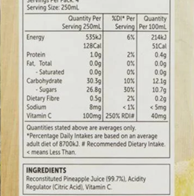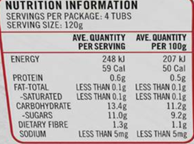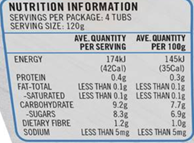
Chris Leow and James Hart are two nutrition and dietetic students who recently wrote a selection of nutrition blogs as part of the STEW program under Jayne Barbour’s supervision. I told them their posts could have a home on the Student Health and Wellbeing Blog and am very happy to include one of those posts below on sugar intake.
How do you like your coffee? With a teaspoon of sugar? Or maybe a whole lot, like Bart Simpson? In this blog, we will explore what free sugars are and we will also see how easily we over-consume sugars in a day.
We’ll delve into how much we are actually having on a normal day. You might be surprised!
Last but not least, we’ll share some sugar-savvy tips, and unpack what nutrition labelling around sugar means. Let’s begin!
You might have heard that sodas are bad and not to eat too many lollies. This advice is based on the idea of limiting free sugars in our diet.
Free sugars are sugars that are added to foods and drinks, as well as sugars that are already present in honey, syrups and fruit juices.
Free sugars do not refer to sugars that are naturally present in whole fruit or plain milk. This is because the fructose in fruit and lactose in milk are naturally occurring and do not contribute to health problems the way added sugar does. Plus, whole fruit and plain milk contain other nutrients beneficial to health such as fibre for a healthy gut and calcium for strong bones.
The World Health Organization recommends limiting free sugars in our diet to a maximum of 12 teaspoons (50g a day). Most of us exceed this by at least 10g. Let’s take a look at a typical day of eating and how quickly the sugars add up!
Breakfast
– 2 Weetbix, ½ cup milk, 1 tsp sugar –> 5g of sugar
– 1 glass orange juice -> 19g of sugar
Morning tea
– Iced coffee (300mL) –> 26g of sugar
– 2 sweet biscuits –> depending on what type of sweet biscuits, between 3-10g of sugar
Lunch
– Sandwich
– Fruit
Afternoon tea
– 2 sweet biscuits –> 3-10g of sugar
– Coffee, black, 1 tsp sugar -> 5g of sugar
Evening meal
– Roasted potatoes, roast meat, steamed veggie
– 2 scoops ice cream –> 22g of sugar, add 20g of sugar for a tablespoon of sauce!
Supper
– Small chocolate bar -> 20g of sugar
That’s 122g of sugar in a day! 😲
The top sources of sugars in the Australian diet are:
- Soft drinks (unless diet soft drink), energy drinks and electrolyte drinks
- Fruit and vegetable juices and drinks
- Lollies and chocolates
- Cakes and muffins
- Cordial (unless diet cordial)
——————-
Did you know that fruit juices are not the same as fruit drinks? Fruit drinks often have sugar added into them.

It is always best to have a whole fruit rather than a glass of juice, because juicing removes the fibre, which is important both for healthy bowel movement and to keep you fuller for longer. A glass of orange juice uses 3-4 oranges, and sometimes you might have more than one glass of juice a day. On the other hand, you most likely would not eat that many oranges. The table below shows simply how you can reduce your sugar intake by replacing a glass of fruit drink or juice with a whole fruit.

——————
Savvy sugar-smart tips:
- Identify the top sources of sugar in what you eat and drink across the day. What could you swap? What are the non-negotiables?
- Swapping – where possible, include less processed whole foods. For example, instead of a glass of fruit juice, have a piece of fruit! Instead of a flavoured milk, choose plain milk. Maybe you could try replacing a soft drink with a diet version.
- If you don’t feel like swapping, limit the portion size, share it with a friend or have less during the week.
- Plan your snacks and desserts
- How much sugar is OK when choosing something? This resource by Eat for Health teaches us how to read a nutrition label. Speaking of which…
——————
Have you ever seen sugar claims on food packaging? ‘No added sugar’, ‘sugar free’, ‘less sugar’…etc…What do they all mean? We’ll debunk some of them here!
Claim: no added sugar
What it means: Exactly what it says – no sugar was added! However, there may be a lot of naturally occurring sugars, such as fruit juice. You still want to be wary of this because naturally occurring sugars also contribute to excess calories which can lead to weight gain.
Example: As you can see from the ingredients list, this fruit juice contains only pineapple juice, acidity regulators and vitamin C. There are no added sugars! However, the total amount of sugar per glass (250mL) is still a fair bit – 26.8g

Claim: Reduced sugar, Light or Lite
What it means: This means that the product contains 25% less sugar than a similar product of the same brand…but it still might be a lot, especially if the original product was high in sugar.
Example: This brand’s fruit tub contains 11g of sugar for each tub.

In comparison, the reduced sugar fruit tub contains 8.3g of sugar. However, as you can see in the ingredients list, sugar is an added ingredient.

Claim: % sugar free or low sugar
What it means: The product contains less than5g of sugar per 100g (solid food) OR 2.5g of sugar per 100mL (drink)
Example: This 95% sugar free baking chips contains 4.9g of sugar per 100g… cutting it close! However, it also contains 35.1g of saturated fat which is not ideal. Read our upcoming post on Fats to find out why.

This low sugar granola contains 2.9g of sugar per 100g.

We hope that you have learnt something new from this post. Did anything surprise you? Leave a comment below! We’d love to hear your thoughts.
References
Australian Bureau of Statistics. (2016, April 27). Australian Health Survey: Consumption of added sugars, 2011-12. https://www.abs.gov.au/ausstats/abs@.nsf/Lookup/4364.0.55.011main+features12011-12
Food Standards Australia and New Zealand. (2019, August). Sugar. https://www.foodstandards.gov.au/consumer/nutrition/Pages/Sugar.aspx
Food Standards Australia and New Zealand. (2017, September 8). Food Standards Code Schedule 4 – Nutrition, health and related claims. https://www.legislation.gov.au/Details/F2017C00711

